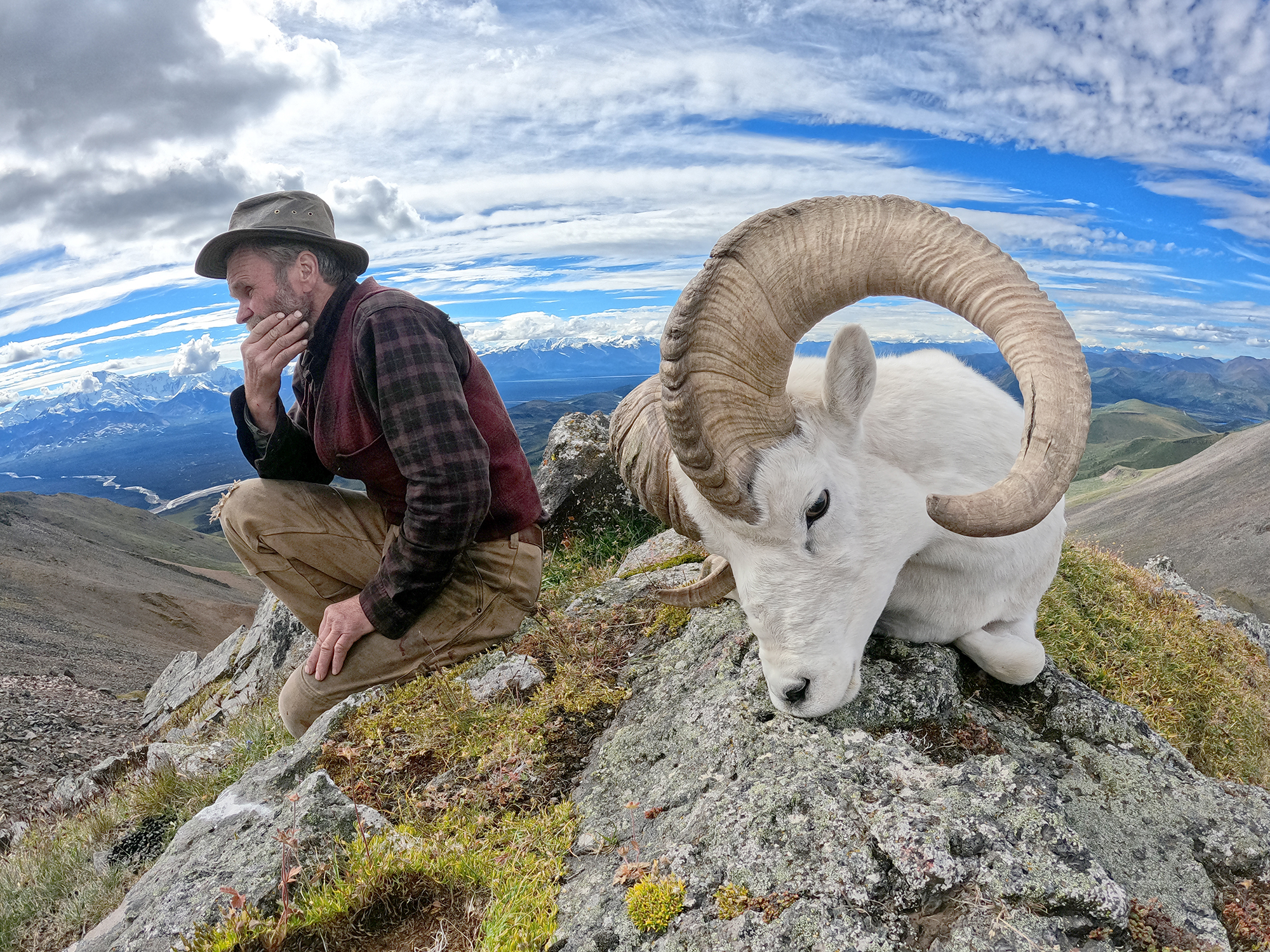ON A HILLSIDE a half mile below us, three rams graze on lush, green grass. A few hundred yards to our left, four young rams are bedded in a dirt patch. And across the valley, on the far ridge, dozens of white dots flicker in my binoculars. Before today, I had never seen a live Dall sheep, though I had read about them, watched videos about them, edited stories about them, and dreamed about hunting them for years. Now there are Dall sheep all around me.
Through my binoculars, the distant sheep look like Mary’s little lamb, fleece white as snow. But through my guide Rod Collin’s spotting scope, turned up to 60X, I can see their stocky, muscular frames. I can see brownish-yellow horns curling back behind their ears. My heart races at the sight. More rams.
“Just young ones,” says Collin, a veteran guide with no wonder in his voice. “We’ll keep working along this ridge.”
We spent the morning riding and then climbing to this ridgetop, and from here we can glass into two basins. There are sheep in both, but so far, neither holds the type of ram we’re looking for: at least 8 years old with horns that curl up beyond the bridge of his nose, or even better, an ancient ram with massive horns that are broomed (broken off at the tips).
This is, after all, a trophy hunt, a term that many Americans and even many hunters are uncomfortable with. This fact makes sheep hunting in the Yukon sustainable and at the same time threatens its future. Very few American hunters will ever get to chase Dall sheep, and the weight of the opportunity weighs heavily on me, even on this second day of our hunt. I very badly want to kill a ram. But even more, I want to be worthy of the chance to do so. Because if I’m being realistic, this is probably the only chance I will ever get.
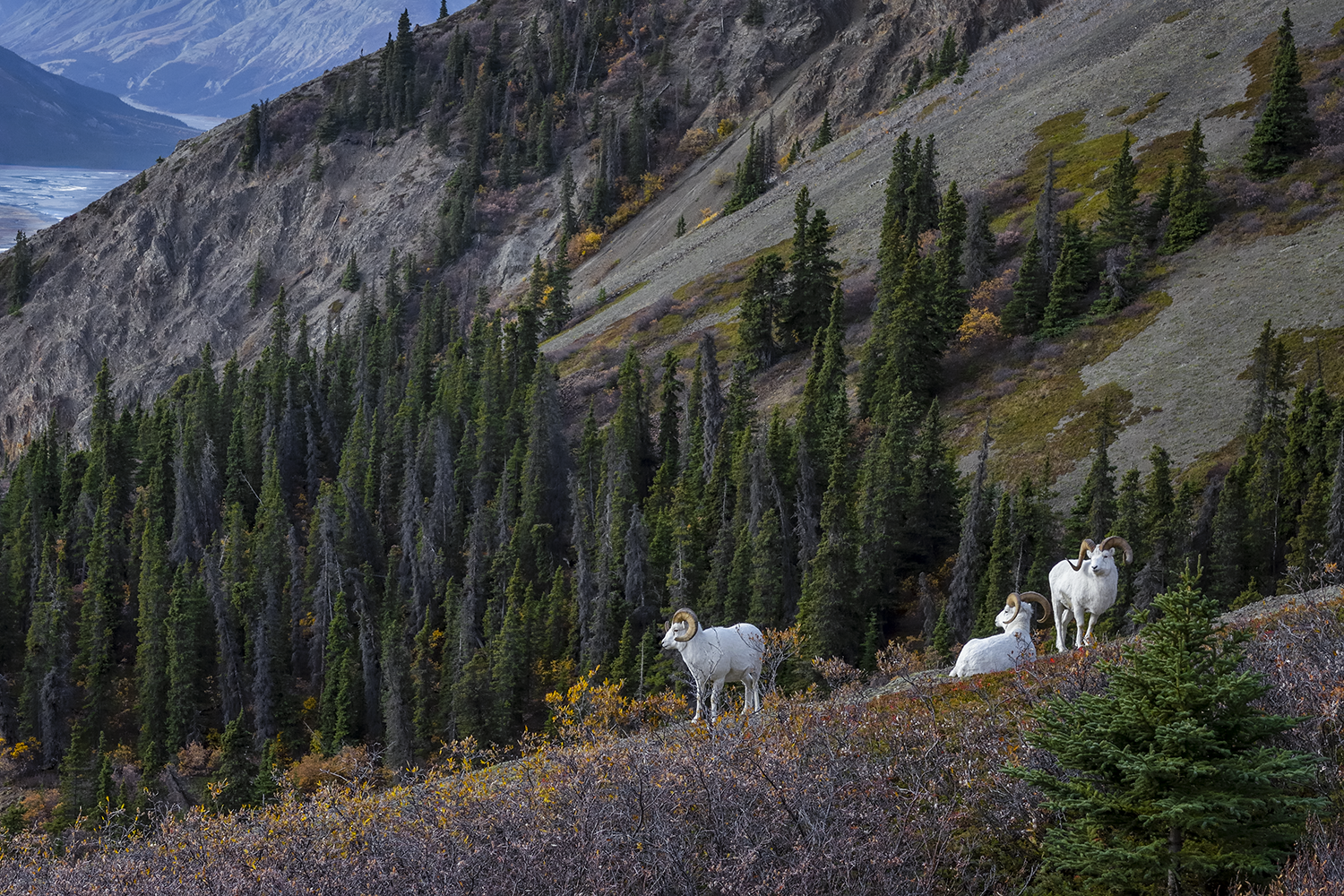
HISTORY IN THE HIGH COUNTRY
The pursuit of mountain sheep, at least for white North Americans, has always been a niche endeavor, if not necessarily always a prestigious one. In the early 1900s, America’s big-game hunters simply weren’t infatuated with trophy rams the way we are today, and sheep hunting was mostly left to local mountain men. That’s what Jack O’Connor, Outdoor Life’s late shooting editor and a famed sheep hunter, wrote in his book Sheep & Sheep Hunting.
But over the course of several decades, popular magazines like Outdoor Life published sheep-hunting tales of high adventure—many of them took place in the Yukon and were written by O’Connor himself—and the mountain sheep’s stature as a trophy animal began to grow. In fact, the largest North American ram that O’Connor ever killed was a massive Dall sheep taken from the Yukon’s Pilot Mountain.
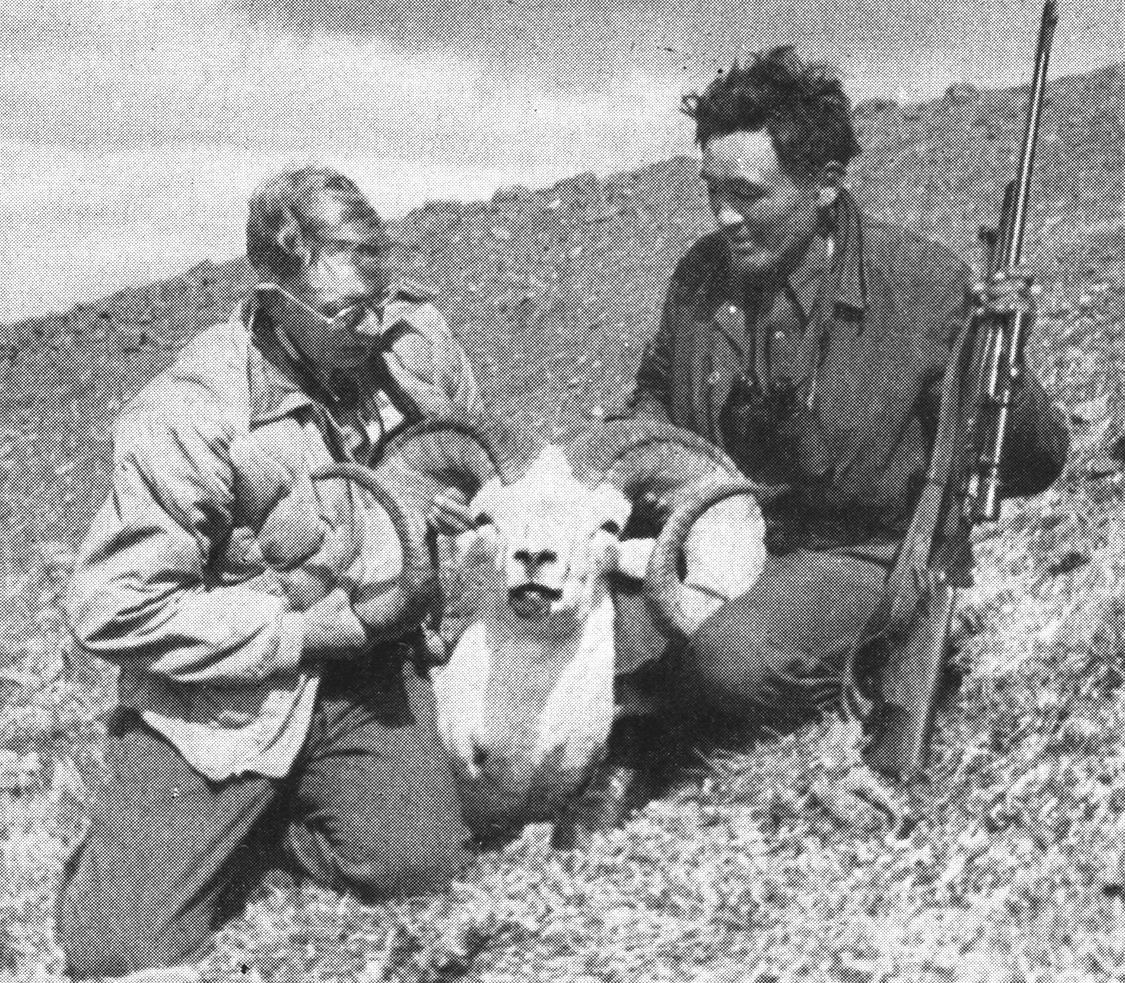
These stories were made possible by the expansion of outfitting businesses in the Yukon, the very oldest of which was established in 1902 by Thomas Dickson. He first came to the territory as a member of the North-West Mounted Police for the historic Klondike Gold Rush and then homesteaded an area with his wife, a Tlingit woman. Generations of Dicksons took over the business after Thomas, and they still run it today. Teah Dickson, Thomas’ great-granddaughter, is serving as the wrangler for my hunt. She’s been riding horses and traveling the backcountry since she was a toddler, and after spending three days with her, I conclude that she’s the most competent 25-year-old woman I’ve ever met.
In the old days, Yukon outfitters would load a pack string and head out with their hunters for a month, maybe two. They would hunt moose, grizzlies, and caribou along with trophy rams, and for a time, the regulations allowed hunters two sheep tags.
“The old-timers hunted sheep because they loved sheep, because they loved to be up on those high windswept ridges where they shared the sheep pastures with the sheep, the grizzly, the hoary marmot, the soaring eagle,” O’Connor wrote. “When they brought back a ram trophy, they were not seeking honor and prestige—they were bringing back memories of icy winds fragrant with fir and balsam, of the smell of sheep beds and arctic willow, of tiny, perfect alpine flowers, gray slide rock, velvet sheep pastures. The old-timers had sheep and sheep hunting in their blood.”
Teah’s grandpa and great-uncles would leave from Whitehorse with their clients and ride for days before even reaching sheep country. O’Connor believed the time investment required to take a trophy northern ram was what made the hunt meaningful. The trips are shorter today, but you can still see that sentiment in the Dicksons’ outfit. Even though many of his clients fly private jets into Whitehorse and can jump from home to base camp in a single day (and then fly out after killing their ram), Dave Dickson, Teah’s father, always encourages his hunters to stay longer. The Dicksons want their hunters to get the full Yukon experience, which includes long horseback rides and some quiet days in camp. It’s the antithesis of a hunting style that’s becoming popular in the Northwest Territories, where outfitters fly their hunters up the mountains in helicopters—and just as quickly fly them and their sheep out.
Hunting in the Yukon still means traveling by bush plane, on horseback, and finally on your own two feet. I’m happy to stay here for as long as I can.
HALF-CURLS
On the third day of the hunt, I follow Collin and Teah up the basin on horseback until we reach a slope that’s too steep for the horses. From here we hike to a peak where Collin spotted a band of rams yesterday. He thought one of them could be a shooter and deserved another look. I’m able to keep up with Collin, the 63-year-old guide, on the straight climbs, but any time we get to technical terrain, like steep scree slopes, snow-slick boulder fields, or narrow rock ledges, the old man pulls away from me. There’s no amount of stair climbing or trail running that can prepare you for traversing these hazards swiftly. So I go slowly, and safely.
But when we get to the top, we’re greeted by a sheepless slope below us. We take a minute to rest and soak up the view of distant, snow-covered peaks shooting 14,000 feet into the blue. Today there are no planes—or signs of human life, for that matter. The Yukon is still home to some of the most remote wilderness on the planet. Approximately 43,000 people live in the territory, an area larger than the state of California—and the vast majority of Yukoners live in Whitehorse.
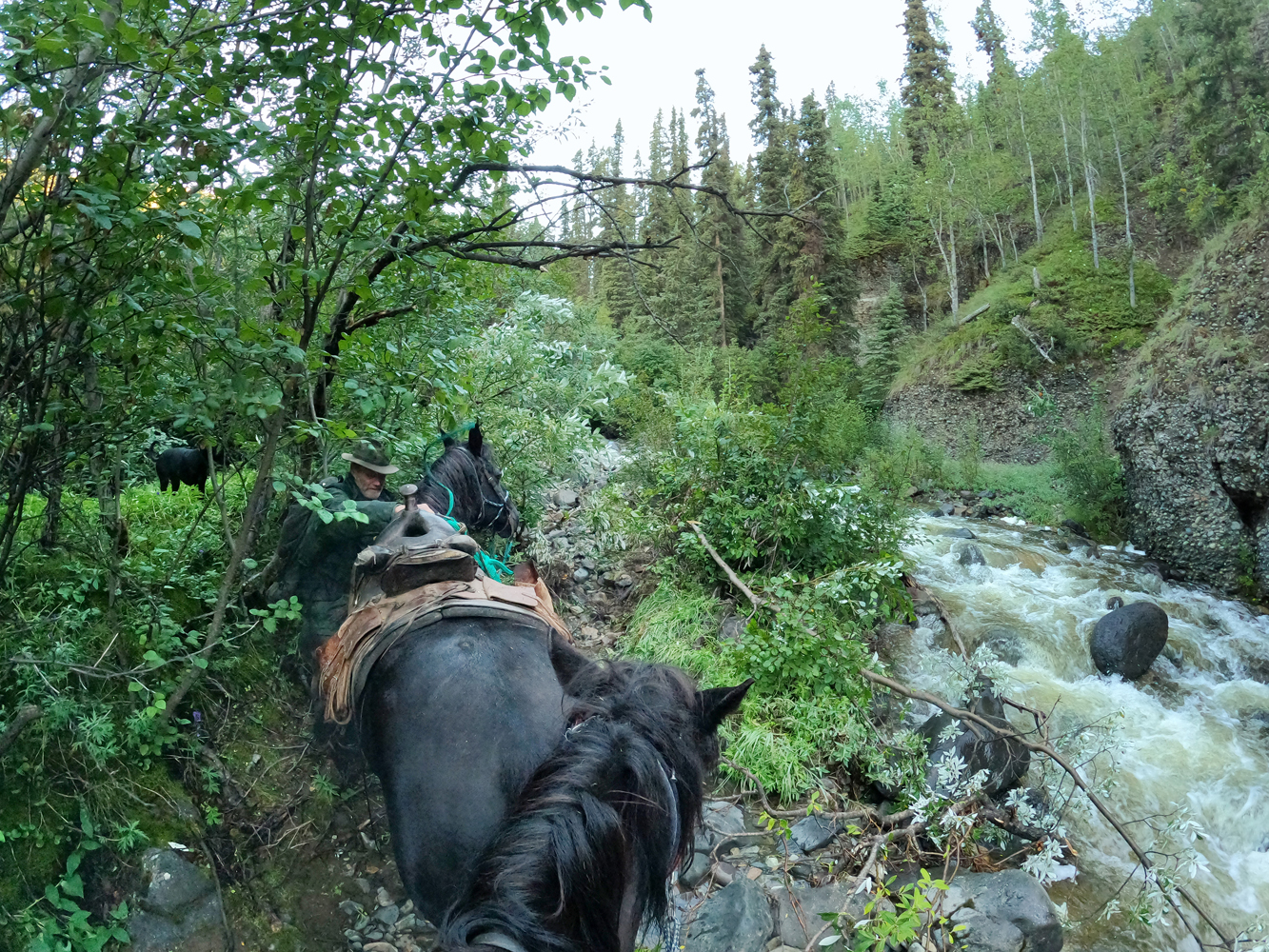
But we’ve heard from Dave that there will be “helicopter traffic” in our area later in the week. This is likely related to mining exploration, and likely very bad for our hunting. Sheep do not stick around when planes or helicopters are buzzing their peaks.
The sooner we can find a shooter ram, the better. So we hike down our peak and up the next one. There Collin sneaks over the edge to spot two rams bedded not 60 yards below him. But they’re young, half-curls. We glass more sheep throughout the day. Some bedded, some feeding, some dashing across the mountainside like a band of miniature white quarter horses, seemingly for no other reason than because they can.
There’s only one ram that piques Collin’s interest. But he’s borderline, and he’s bedded at the top of a lone rock outcropping—an impossible place for an ambush.
At some point during the evening, we hear a barrage of gunfire coming from the adjacent unit. Four shots in quick succession. Then three or four more. Then there’s a lull for about 10 minutes, and we hear two more quick shots. We exchange winces. Usually shooting like that does not end with a tagged animal and a happy hunter.
Eventually we hike, and then we ride, down to our wall tent spike camp, which is surely buzzing with mosquitoes waiting for our return. Collin hums a song to his horse as we go.
THE SHEEP-HUNTING BOOM
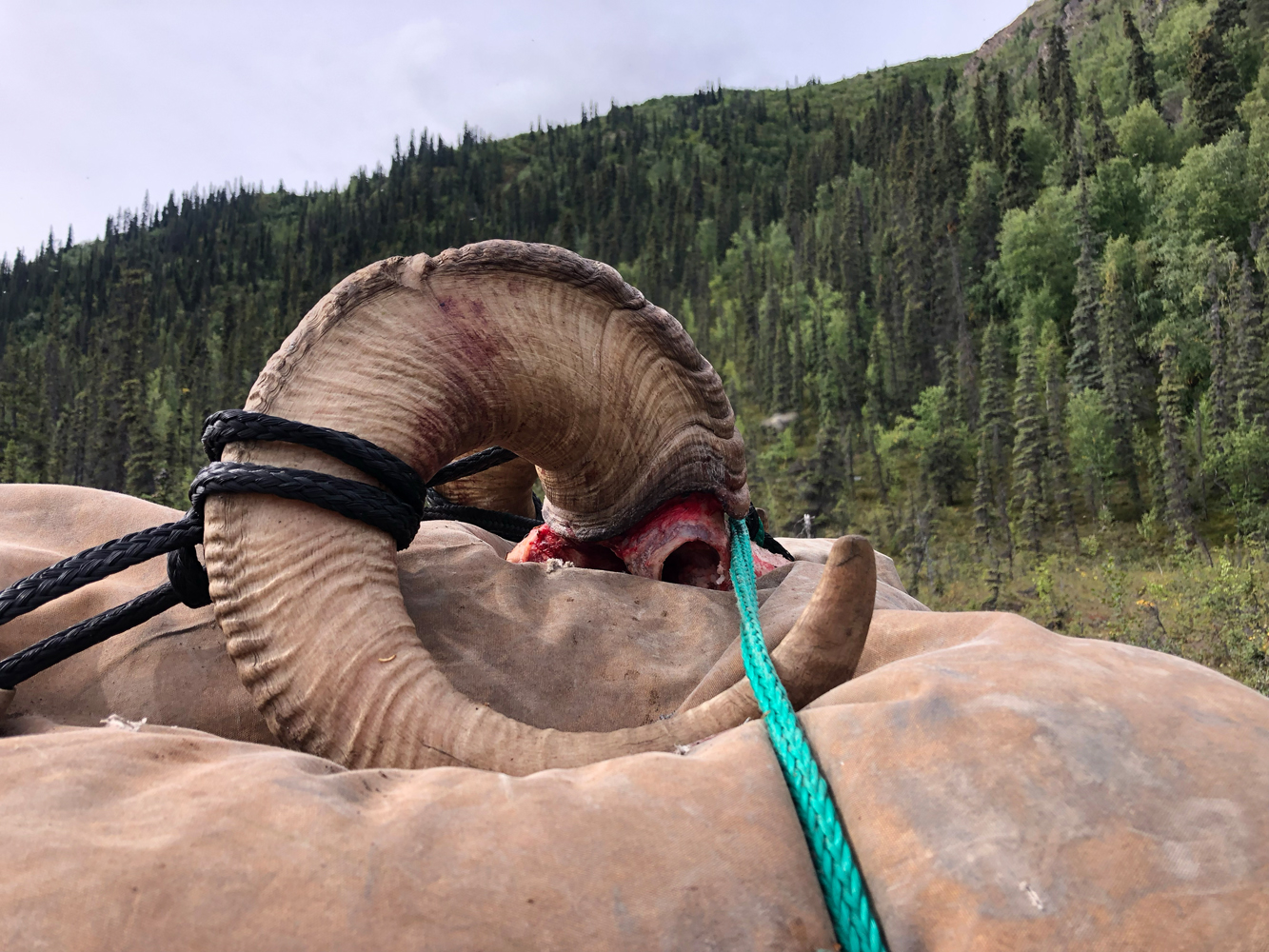
If high-speed travel has made sheep hunting more accessible to wealthy hunters, it’s helped raise the price of hunts as well. When Dave Dickson took over the guiding area in the late 1980s, he was running 14-day combination hunts for sheep, moose, caribou, and grizzly bears. Hunters would commonly take two or three species, and on rare occasions, they’d tag all four. At the time, Dave was selling these hunts for $6,500, or about $17,000 in today’s dollars (when adjusted for inflation). Now a Dall sheep hunt alone costs approximately $30,000, which is out of reach for most hunters. A Yukon moose rut hunt costs just as much. Part of the reason for the increased cost is Dave’s increased expenses. He employs a crew of guides and wranglers, and he’s got cabins to maintain and floatplanes and generators to gas up. Then there are the 37 horses the family owns. But the other reason for the increased prices is that hunters are, obviously, willing to pay. His sheep hunts for next year are already booked.
While $30K might sound egregiously expensive, Dall sheep are actually the most affordable North American sheep species to hunt. If you can’t get lucky and draw an exceedingly rare tag in a lottery, then an outfitted Stone, bighorn, or desert bighorn hunt can cost you $50,000 or more.
For several decades now, the sheep-hunting boom has been driven in part by hunters hoping to take a grand slam—all four species of North American sheep—which O’Connor wrote “became the Holy Grail of American hunting.” The Grand Slam Club has documented more than 2,000 legally taken grand slams as of 2018.
O’Connor saw what the idea of the slam, and all the competition around it, might do to sheep hunting. He harshly described those folks who wanted to “knock off a trophy ram and get the hell out as quickly as possible” as “Instant Hunters,” which was an especially prescient critique considering it was written some 40 years before Instagram and the rise of the Insta hunter.
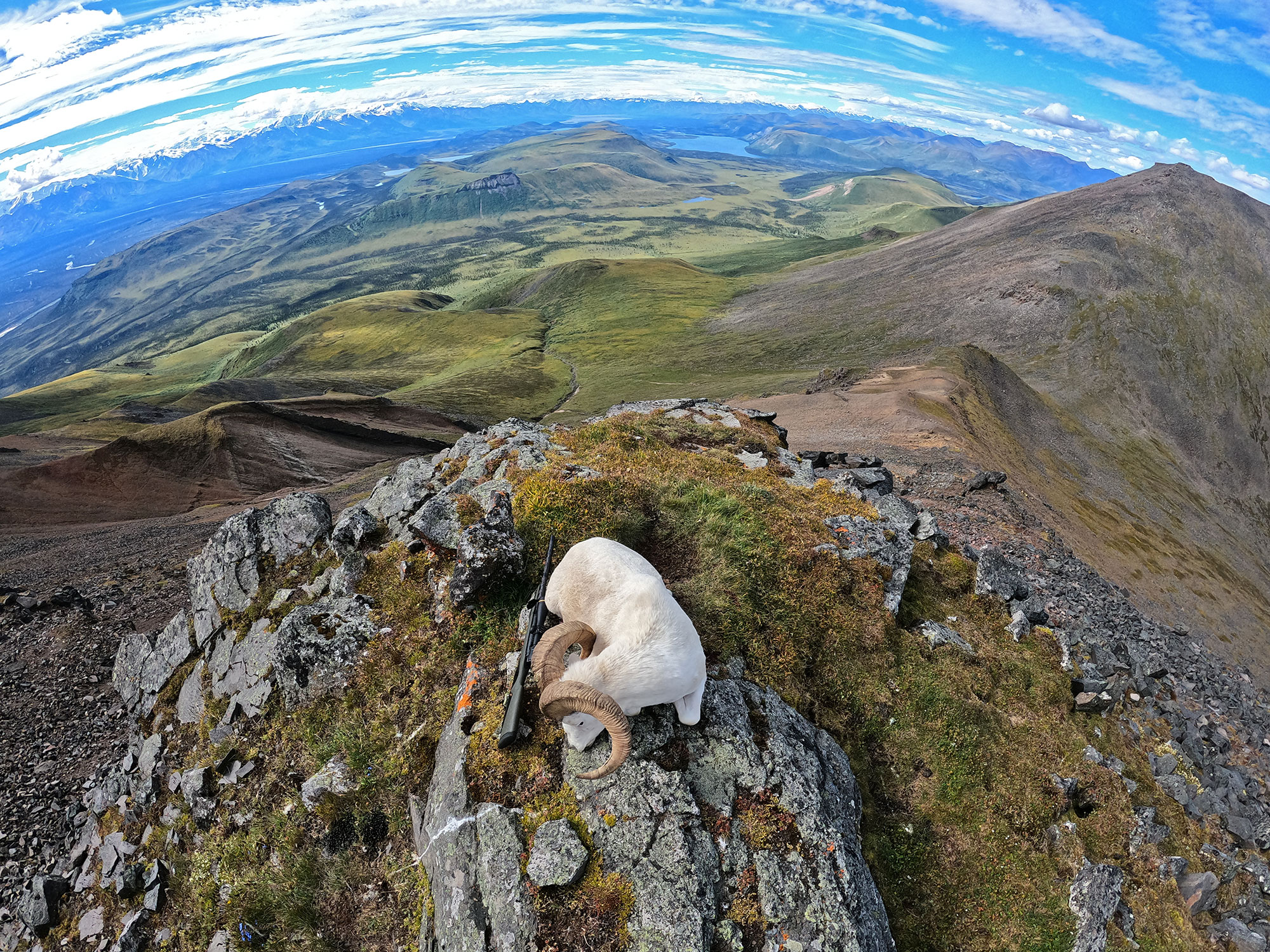
“Today, alas, many sheep hunters apparently care little for sheep and even less for sheep country. They are after glory and prestige and the sooner they can get the tiresome business over with and slap those ram heads on the wall, the better they like it,” he wrote in the 1970s.
But O’Connor also acknowledged he was at least partly to blame for all the sheep madness.
“Some of the boom in sheep hunting may well be laid to my doorstep,” he wrote. “I hope that when I arrive at the Pearly Gates, old St. Peter does not hold it against me. He may well do so—and if he does, I shall not argue. I’ll simply bow my head, turn around, and go down below where I belong!”
GUIDES AND THEIR HUNTERS
Maybe the Dicksons knew about my desire to experience O’Connor’s Yukon when they paired me with Rod Collin, who has been showing sheep hunters around the mountains for more than 40 years. When I ask Collin what size ram we’re targeting, he says, “I’d love for us to kill a 9- or 10-year-old ram. A sheep like that has already had the chance to breed, and they usually don’t live all too much longer.”
From what I can tell, Collin has only three pieces of modern equipment: his cellphone (for photos), a Swarovski 60X spotting scope (for aging rams), and a satellite phone (for calling his wife on her birthday). The rest of his gear seems to be from the ’80s or earlier.
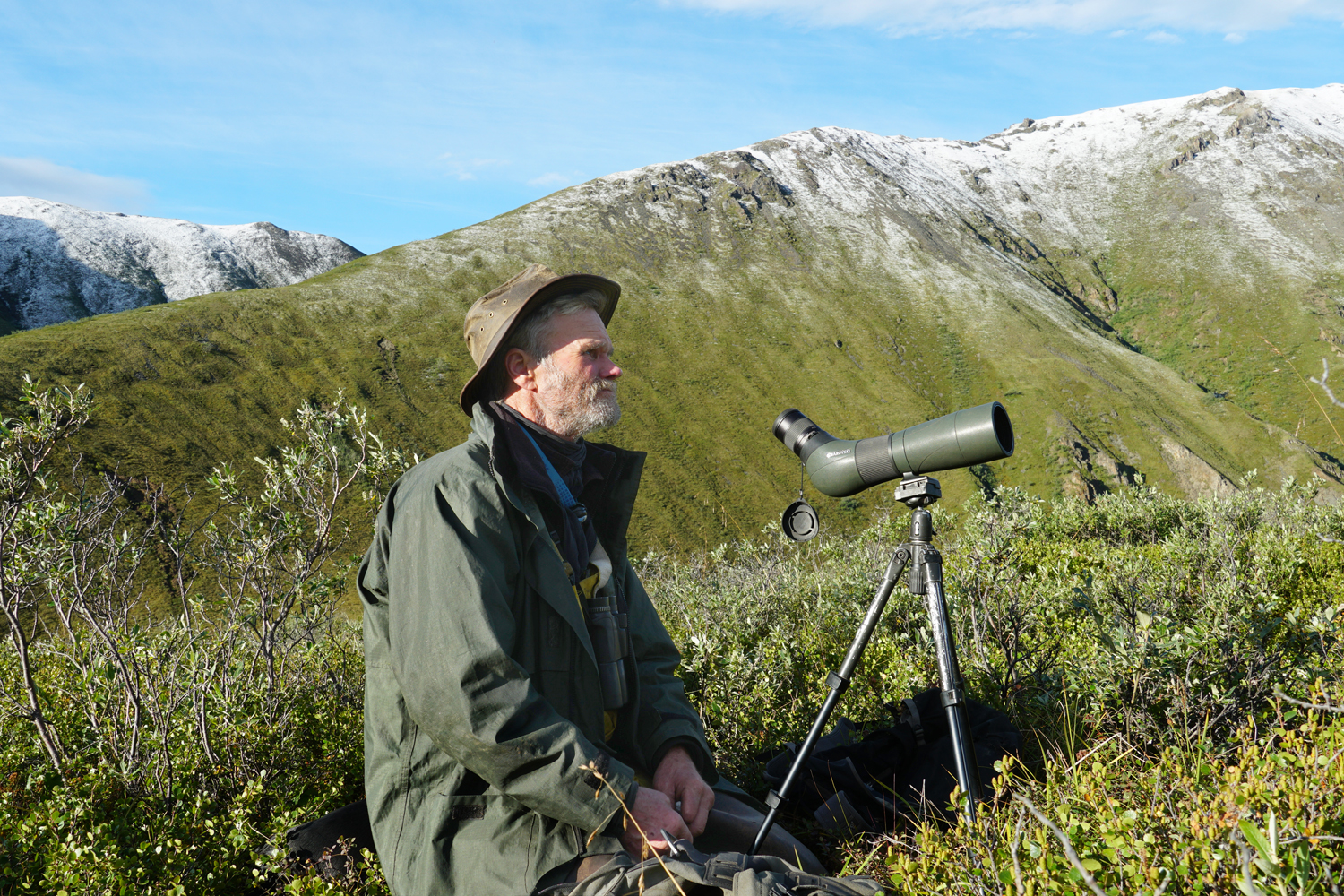
Like O’Connor, Collin believes that rams should be killed at relatively close ranges—300 yards and in. This is to ensure that a mature, legal ram is taken with a quick killing shot. Even in today’s age of ultra-accurate hunting rifles and precision scopes, Collin maintains his old-school mentality.
“There’s almost always a way to get within 300 yards,” he says. “It just might not always be right away.”
Of the hundred-plus rams he’s guided hunters to, he’s lost only one to wounding. When he’s not guiding, Collin works as a carpenter and collects first-edition Arctic and wilderness exploration journals. He’s gruff but polite in camp. He’s generally a quiet man, but over the course of a week, I manage to scribble down some of his best lines in my notebook:
On putting raisins in apple pie: “I like raisins as much as the next guy, but anyone who puts raisins in apple pie should be taken out back and beaten with a two-by-two.”
On Betty the horse: “She was the ignorantest old bitch I’d ever seen.”
On cooking dinner for the camp: “I’m busier than a one-armed wallpaper hanger.”
On polygamy: “More wives, who would want more wives? I’d want more husbands for my wife. I’d have one guy who was a good electrician, a guy who knew plumbing, a welder, and one young guy to do all the heavy lifting. As for me, I’d be husband number one. I would just make sure everyone was doing their job.”
In his younger days, Collin guided backpack sheep hunts, meaning that on hikes back to base camp he’d have to pack a full sheep plus the entire camp out on his back—for miles. The heaviest pack he actually weighed tipped the scales at 140 pounds. Clients were rarely able to help pack out an animal (though he says Jim Shockey was one of the few exceptions).
“They were already giving it everything they had,” Collin says.
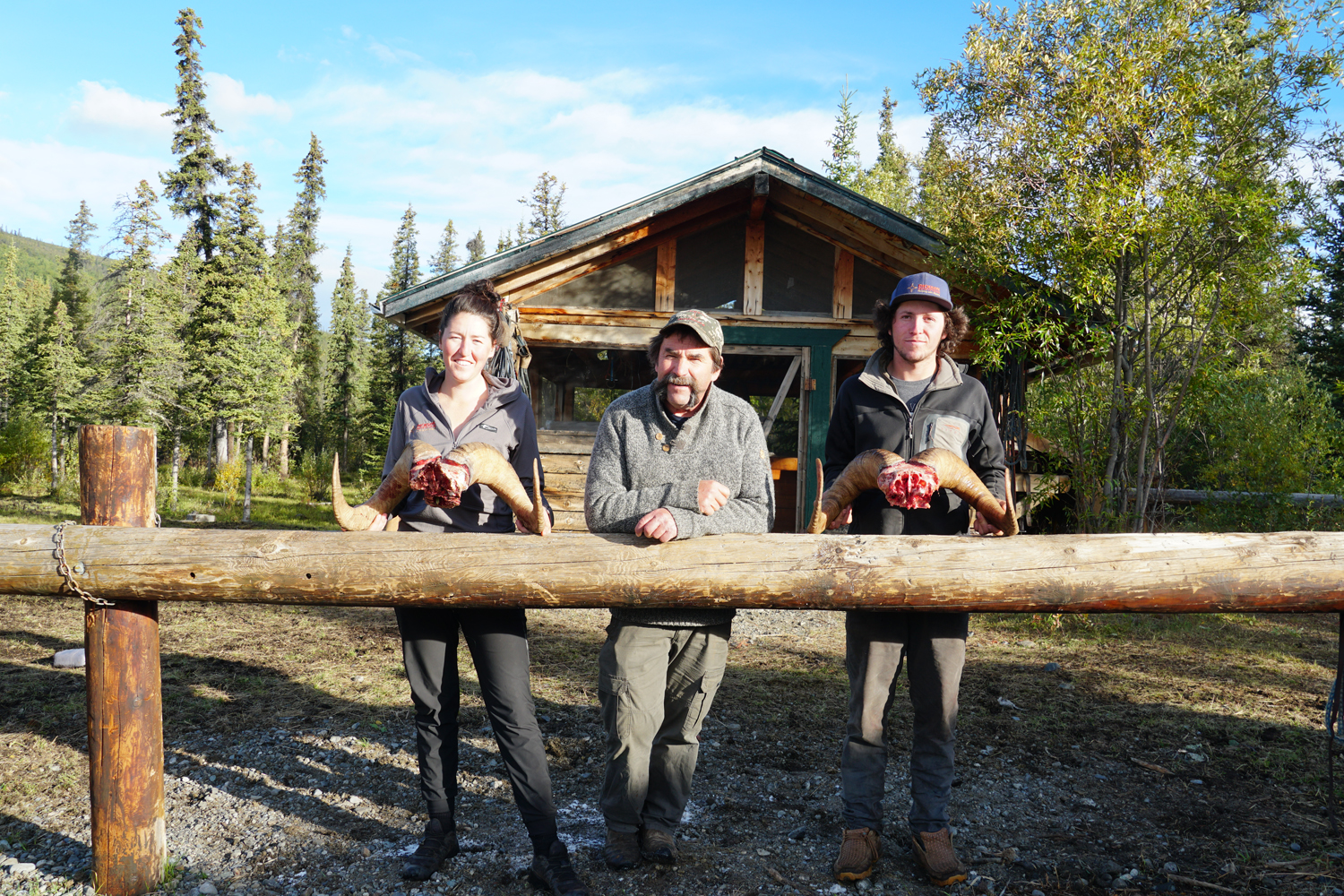
There is a common type of sheep hunter who wants to kill a ram, sometimes very badly, but doesn’t necessarily like sheep hunting itself. For that hunter, the mountains are too steep, the bugs are too thick, and the air is too thin for any of it to be enjoyable.
“For some of our hunters, this will be the hardest thing they ever do in their life,” says Teah.
One night, after a whisky or two, Collin tells the story of a wealthy and inexperienced hunter who booked a series of sheep hunts in a single year. On the first day of hiking in, before even reaching sheep country, the hunter wanted to quit several times, but Collin convinced him to stick it out. The second morning broke cold and snowy, and the hunter gave up for good.
“Rod, take me off this fucking mountain,” he finally said. “I’ve got to get back to town. I’ve got a Stone sheep hunt to cancel.”
Then there are the sheep hunters who simply cannot get enough. They either like the pain, or the hardships of the mountain don’t feel so hard to them. They hunt sheep every year, or several times a year if they can afford it. One of the Dicksons’ regulars has something like 10 grand slams to his name. He’s a great big man who started a construction company. He climbs the hills by putting his head down and huffing and puffing his way to the top. He never quits, never complains. The Dicksons, and all their guides, absolutely love him.
And lastly, there’s the everyman. For him, this is a once-in-a-lifetime hunt. He’s saved and dreamed for years. And even if he wants to, he’ll never go on another sheep hunt.
“Those are the hunts that bring the most pressure,” Collin says. “They’ve built the hunt up so much in their mind. Then if the weather is bad, or it’s socked in, you can feel the stress rolling off them. Even if they don’t say anything, you can see them getting grimmer and grimmer as their hunt slips away.”
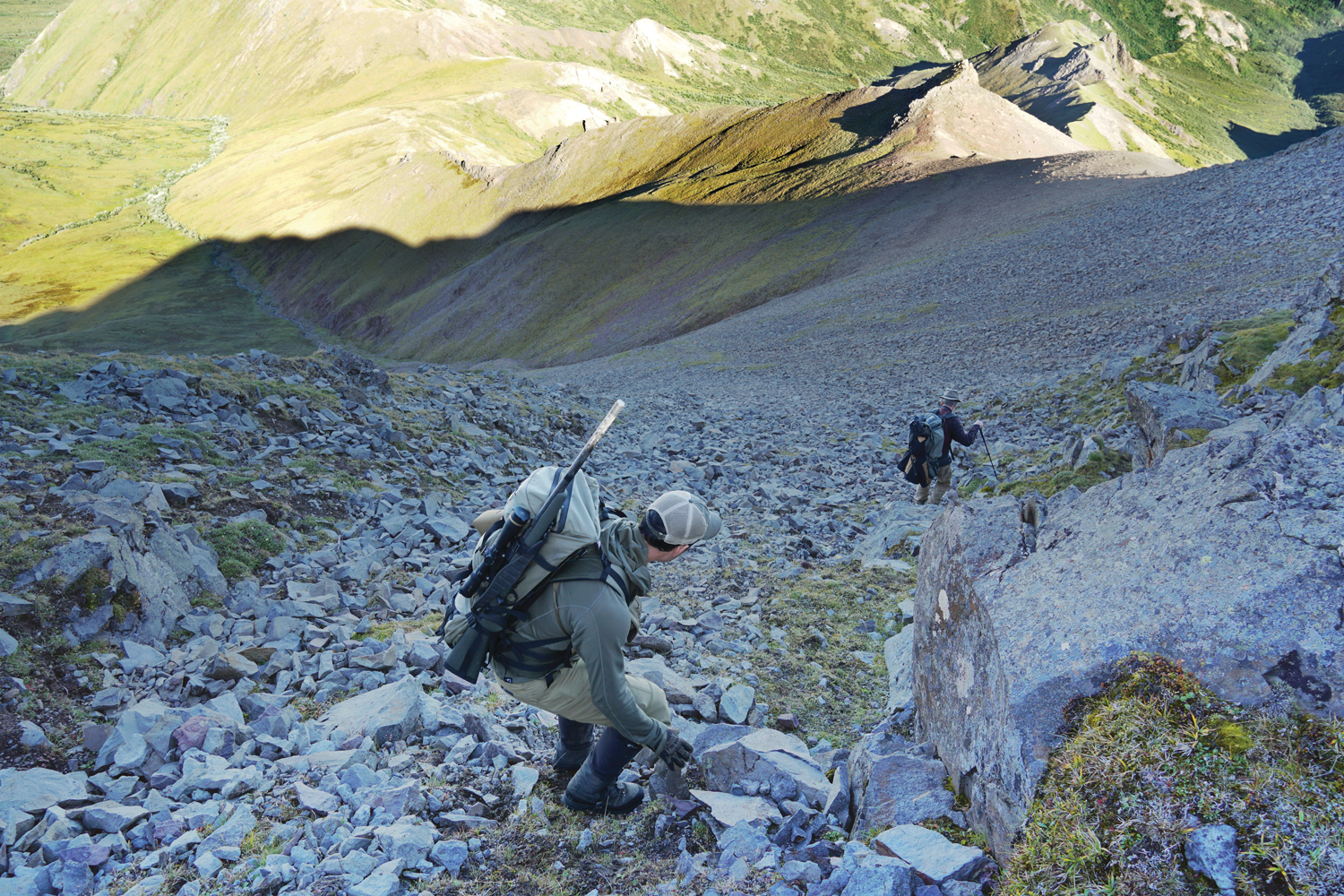
I’m almost certain that I fit in this last category. Even as the editor-in-chief of Outdoor Life, hunting on an invite from Federal Premium Ammunition, I have no idea when my next sheep hunt will be, or if there ever will be another. I try to fight back the grimness creeping in.
MISSING RAMS
Collin suspects we’re not seeing as many mature rams as usual because this area of the Yukon had such a harsh winter. Sheep end their rut in November, just before the teeth of winter sink in, so the oldest and hardest-breeding rams are susceptible to winter kill, Collin says.
In general, wild sheep in the Yukon are doing quite well, especially compared to populations in Alaska and British Columbia, says Kevin Hurley, the vice president and Thinhorn Sheep Program lead for the Wild Sheep Foundation.

Or at least that’s the assumption. There are an estimated 22,000 sheep in the territory, but there’s no real trend data for comparison. There are also large expanses of the Yukon where there haven’t been consistent population surveys.
If the sheep population remains an unknown, the downward pressures facing sheep are well known. In the Yukon, that means habitat loss and disruption from mining activities and ever-increasing human pressure from off-road vehicles in the mountains, Hurley says.
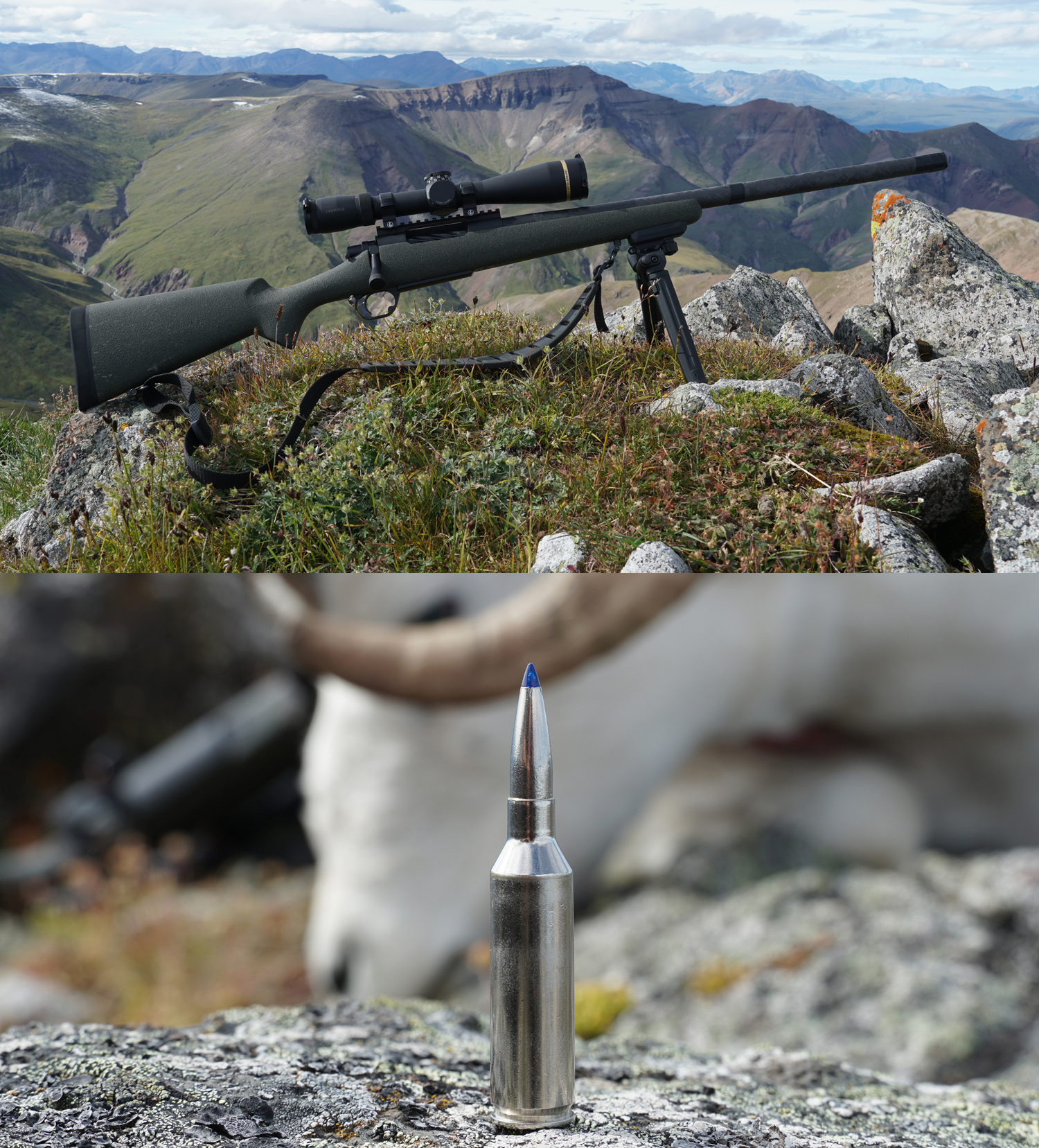
Then there are the environmental pressures. In the winter, sheep need wind-swept ridges where they can access food. Heavy snowpack or, even worse, wet snow that freezes over can lead to major die-offs. Dave Dickson says he lost half his sheep population after a brutal winter in 2008, and he cut his sheep hunts from nine hunters per season to two. As the climate in the north country changes, some predict these winter conditions will get worse for sheep. Plus, brushy plants tend to creep to higher elevations in a warming climate. That effectively shrinks the grassy, open slopes where sheep thrive.
Dave has seen firsthand the effects of a changing climate. As the permafrost melts, the holes in his horse trails keep getting deeper and deeper. But it’s government overreach and influence that Dave worries about the most. There have been about 20 outfitters in the Yukon for decades. And even though they bring in millions of dollars of business each year, their economic impact is small compared to that of potential mining interests. Plus, they represent a small subset of the vote. Even though the nonresidents they guide end up killing the lion’s share of sheep, there are far more resident hunters in the Yukon: about 350 guided nonresidents compared to an average of about 1,350 residents. Dave sees more mining, more harvest quotas, and more indifference toward the outfitters’ way of life in the future. He hopes that his son, Thomas, a hard-charging 20-year-old guide, and his daughter, Teah, will take over the concession someday. But he admits there’s no guarantee for them.
READ NEXT: Great Rifles for Mountain Hunting
“People ask me that all the time: ‘Are the kids going to take over the business?’” Dickson says. “I hope they do. But I worry there’s going to be nothing for them to take over.”
THE HIGHEST PEAK
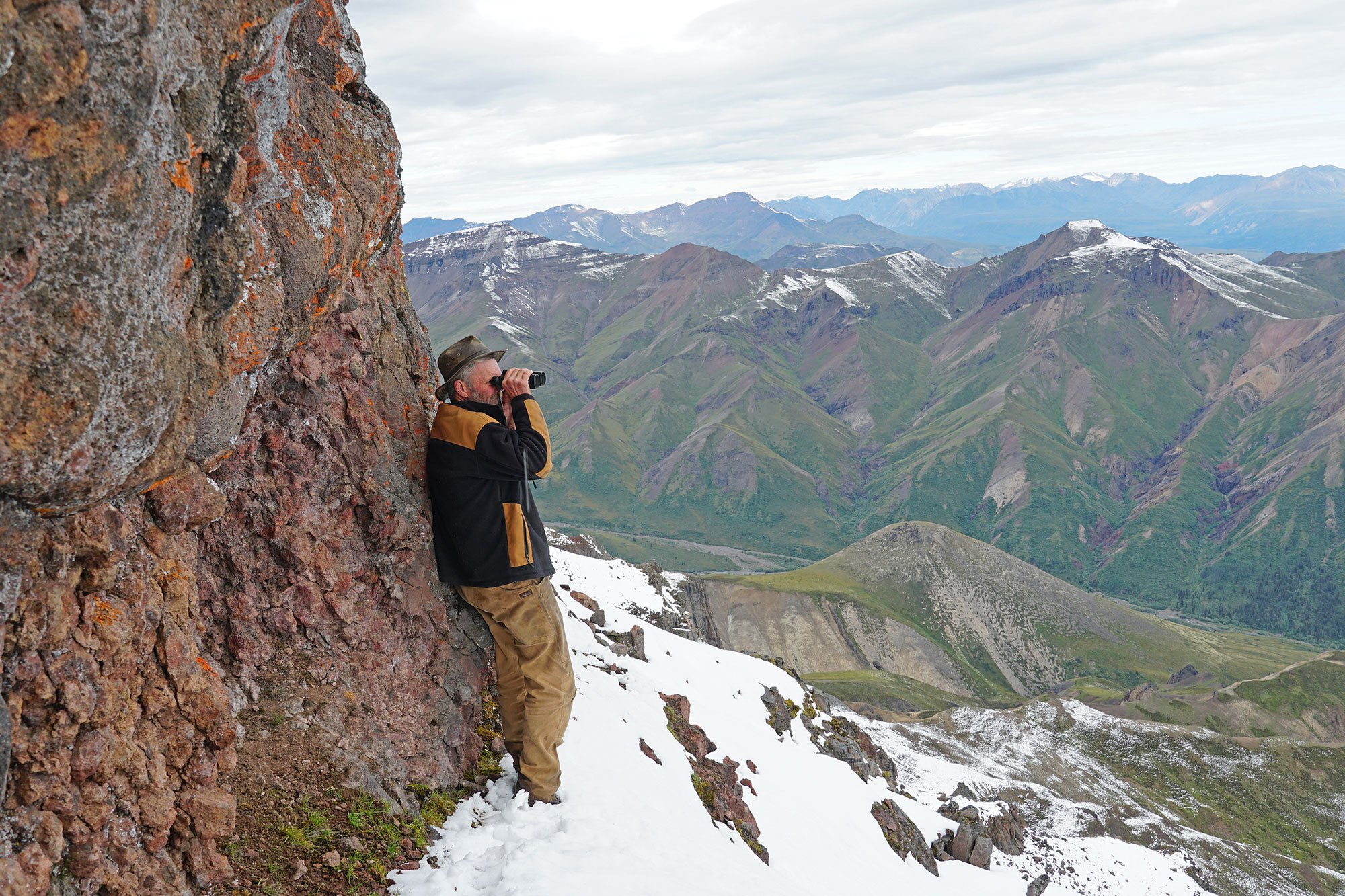
On the fourth day of the hunt, we set out for the same basin. We’ll climb our ridge again and glass into the one beside it. If we see rams with good potential in the next basin over, we’ll pack up camp and move, a process that will take a day. That will give us a day and a half to hunt our new spot before I must ride out to catch my plane home. The alternative, which I like much better, is to find a good ram on our ridge and kill him today.
When we reach the top of the ridge, there are no noteworthy rams in the far basin. But on a plateau far beyond it, Teah spots a plane with massive tundra tires. We watch three men (none of them carrying guns) tromp along the plateau through our glass. Collin guesses it’s the hunter from yesterday’s shootout, along with his guide and outfitter, looking for their wounded ram.
We return our attention to our own ridge, and soon enough, Collin spots a ram that deserves a closer look. I hang back so there aren’t two hunters poking their heads over the top. I have a hard time reading Collin’s poker face, so instead of asking questions, like “Could this be the one?” I just do my best to keep up.
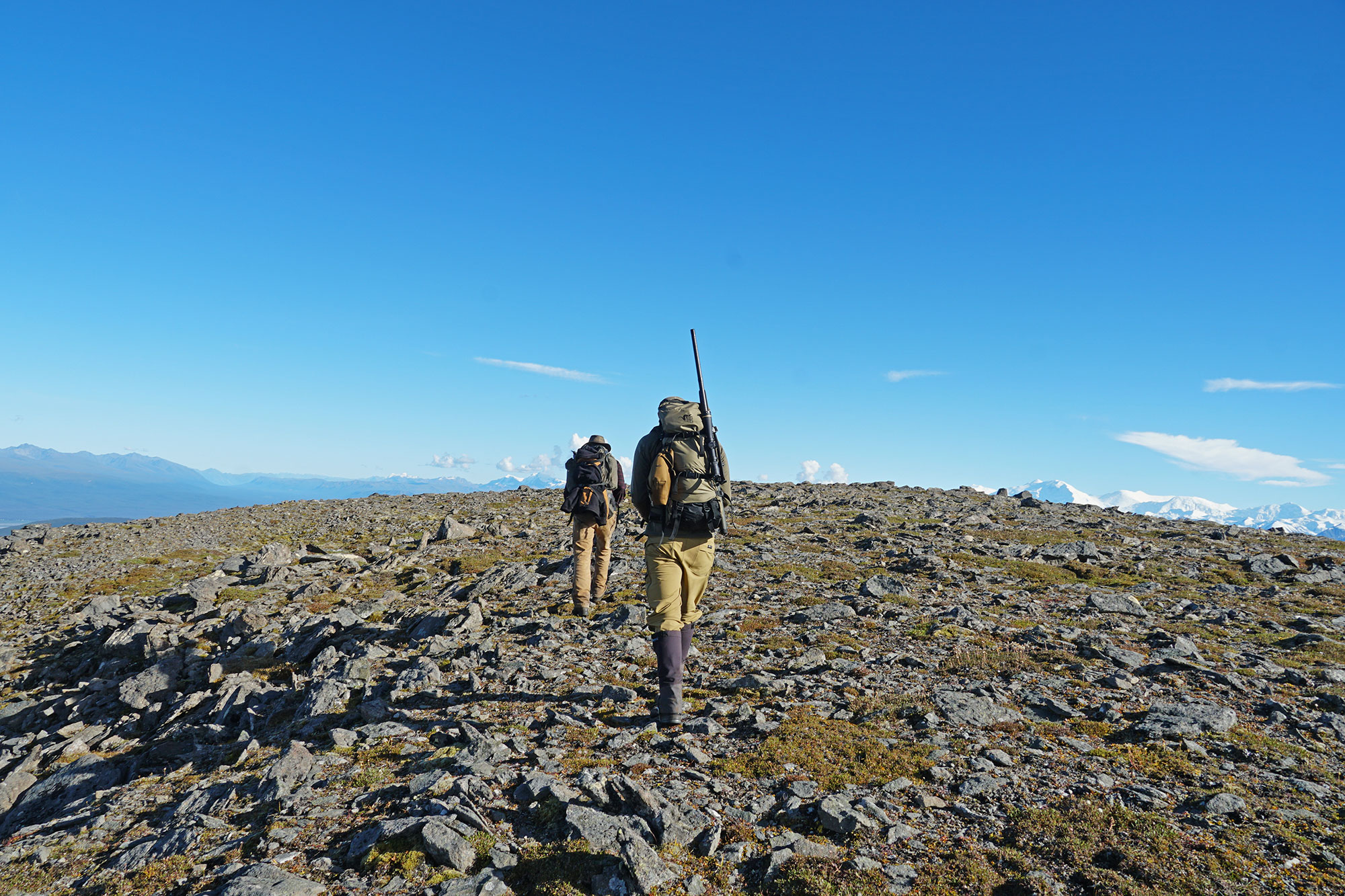
To get directly above this ram, we’re forced to spook another band of rams, which contains a borderline shooter, on a nearby peak. This goes against basic mountain hunting principles, but we risk it anyway. When we finally get to the end of our ridge, Teah and I sit next to some boulders while sheep from another large band, about 600 yards away, stare at us. Collin crawls out to the edge and peeks over at the ram and his two buddies bedded below. In the distance, we can hear the droning of a plane.
After a few anxious moments, Collin turns back to us and gives me the thumbs-up. Right about then, we notice that the plane is flying directly toward us. It’s still probably a mile out, but it’s at our elevation. Then, as if in a scene from a WWII dogfighting movie, the pilot makes a 90-degree turn, throttling the engine and effectively buzzing our tower. The entire band of sheep on the far peak explode from their beds and trot out of sight.
Collin silently mouths an unholy series of cusswords and tries to wave off the pilot. When the plane is at a safe distance, Collin peeks over the ridge once again and then signals me over, this time mouthing, “Hurry up!”
“Give me your gun and lean out over this rock so you can see him,” Collin whispers. “He’s the ram on the left.”
I do as instructed, leaning as far as I dare over a 20-foot ledge. There below me and just 120 yards away, miraculously, is a bedded ram facing away. I scramble atop a little rock outcropping, trying to be fast and stealthy at the same time. Collin hands me the rifle. I throw my shooting bag onto a boulder and slither into an awkward, sideways shooting position. I’m sitting in the wide open now. If any of the three rams below happen to turn in my direction, they’ll almost certainly spot me. Somewhere in the distance I can hear the plane, and it sounds as if it’s coming closer.
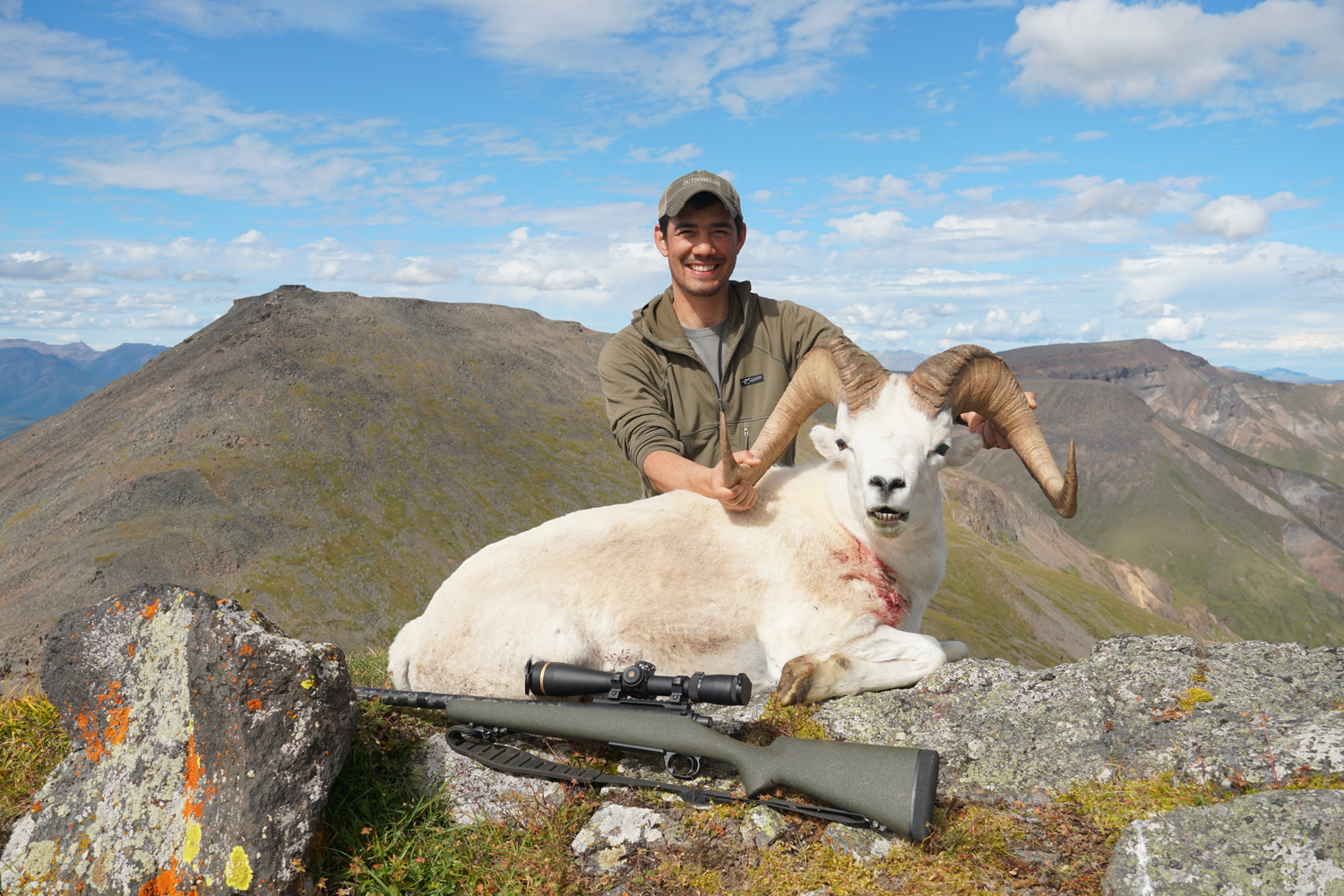
I find the ram in my crosshairs, rack in a shell, and very nearly jerk the trigger, purely out of anticipation that has been building for days and months and years. But that impulse subsides, and my crosshairs settle on the point where the ram’s shoulder meets his neck. I squeeze and hear the reassuring crack of the bullet and then a hearty “You got him!” from Collin.
I cycle a new round and find the ram in my scope. He never rises from his bed, and he’s barely quivering. Still, I stay on him just in case he gets up, but also to be with him at the very end.
When we get down to him, Collin notices that he’s a 7-year-old ram, not a fully mature 8-year-old. Amid the chaos of the plane, Collin never double-checked his count of the rings. This bothers him deeply but doesn’t dampen my spirits at all. I’ve made the most of my opportunity. He’s a legal ram, and to me, a true trophy.
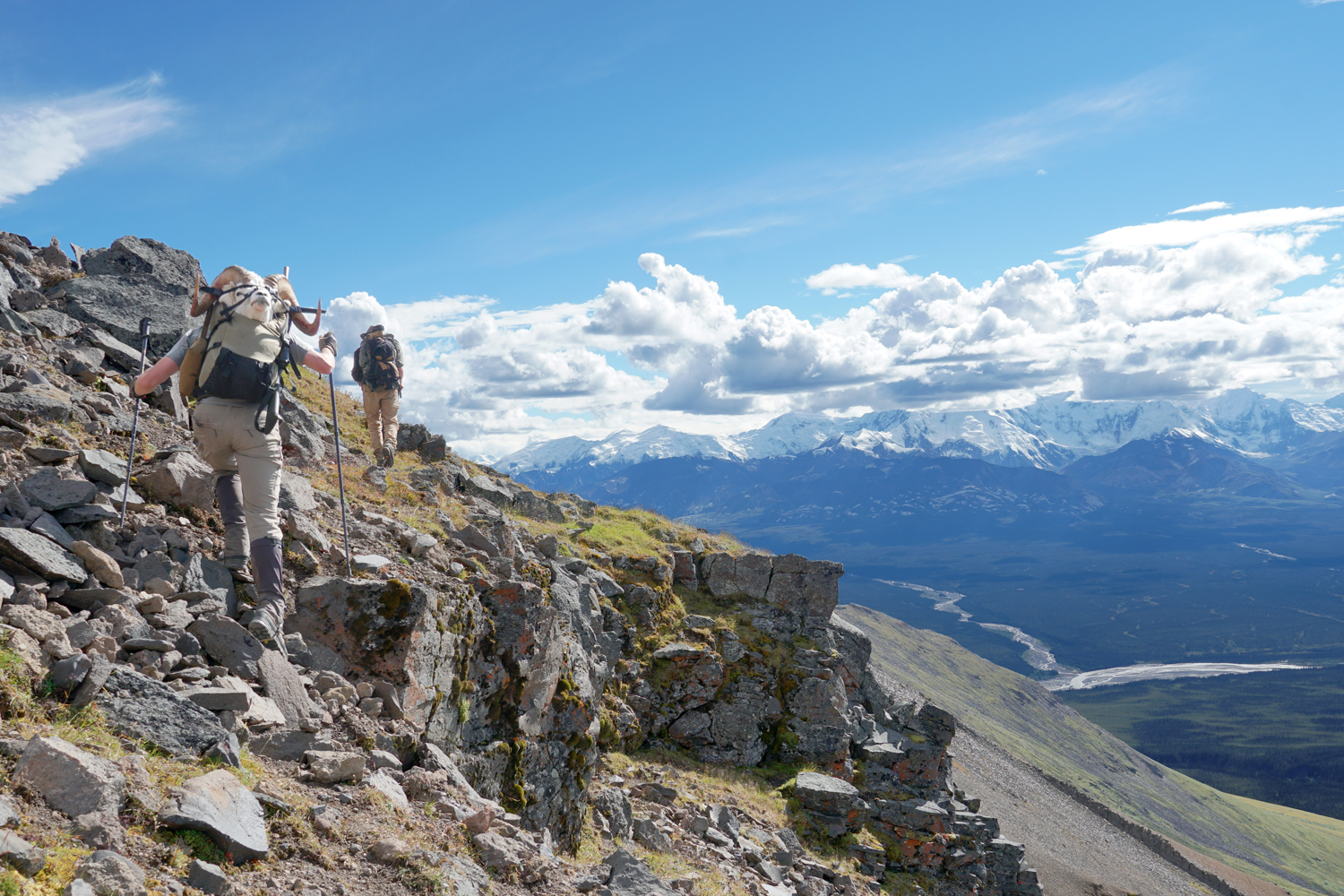
A day later, on the ride back to base camp, with pannier boxes full of meat and the ram’s horns tethered to a top pack, I feel an immense, disproportionate sense of accomplishment. Logically, I know that killing a sheep on a guided hunt is no heroic feat. Plenty of young kids, little old women, and inexperienced, out-of-shape hunters have killed bigger rams. And yet I’ve fulfilled a dream, and the experience was just as sweet as I could have ever hoped.
I also think about O’Connor and wonder if he is, in fact, burning in hell after popularizing and mythologizing sheep hunting through his writing. If he is, I bet he reckons that it all was worth it.
